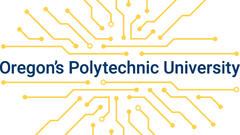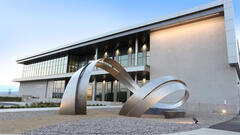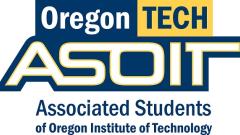Oregon Tech operates under a Bring Your Own Device (BYOD) model. This means students are expected to have stable access to a personal computer that meets the minimum recommended specifications for their degree program. Oregon Tech provides remote access to program-specific software through our Azure Virtual Desktop environment, which is available to all students.

Why the Bring Your Own Device Model?
There are several key benefits to having your own device, including but not limited to:
· Reliable access to cloud resources provided by Oregon Tech
· Personalized setup for your degree field, with guidance from instructors
· Continued access to your work even after your classes are completed
· A more consistent, comfortable, and productive experience when working
Oregon Tech encourages students to choose the brand and model that best fits their academic and financial needs. Below are program-specific laptop recommendations and documentation to help you locate and install your program’s software.
Dell offers a special website with discounts exclusively for Oregon Tech students: www.dell.com/oit
Select a Degree Program
General Laptop Specifications for College of Engineering, Technology and Management (ETM)
Minimum Specs
- CPU: Intel Core Ultra 5 12th Generation or newer
AMD Ryzen 5 (5000 series or newer) - RAM: 16GB
- Hard Drive: 512GB Solid State Drive
- Integrated (Iris Xe/Radeon)
- Screen Resolution/Size: 1920x1080 14" to 15.6"
- Windows 11
- Webcam and Microphone
Recommended Specs
- CPU: Intel Core Ultra 7 13th Generation or newer (9000 series or newer) / Ryzen 7 (8845HS series or newer)
- RAM: 16GB - 32GB
- Hard Drive: 512GB Solid State Drive
- Dedicated Graphics (RTX 3050+/6500M+)
- Screen Resolution/Size: 1920x1080 14" to 15.6"
- Windows 11
- Webcam and Microphone
- Ports: USB 3.2 Gen 2 (2+), Thunderbolt 4+, HDMI
General Laptop Specifications for College of Health, Arts and Sciences (HAS)
Minimum Specs
- CPU: Intel Core i5 12th Generation or newer (9000 series or newer)
AMD Ryzen 5 (5000 series or newer) - RAM: 16GB
- Hard Drive: 256GB Solid State Drive
- Integrated Graphics Card
- Screen Resolution/Size: 1920x1080 14" to 15.6"
- Windows 11
- Webcam and Microphone
Recommended Specs
- CPU: Intel Core i5 13th Generation or newer (11000 series or newer)
AMD Ryzen 5 (7000 series or newer) - RAM: 16GB
- Hard Drive: 512GB Solid State Drive
- Dedicated Graphics Card
- Screen Resolution/Size: 1920x1080 14" to 15.6"
- Windows 11
- Webcam and Microphone
- Ports: USB 3.2 Gen 2 (preferably 2)
Thunderbolt 3 or newer
CSET/ESET Laptop Specifications
CPU: The CPU is important for IT/HI/Cybersecurity software. The CPU computes most of the calculations in your computer. Generally, more cores and higher frequency means a faster CPU. However, it is important to look at benchmarks when comparing processors, especially when comparing AMD and Intel. Websites like www.passmark.com will let you compare performance of different CPUs.
RAM: RAM is extremely fast storage that programs use to store data for quick access. Generally, the more RAM in a computer means it can run more programs at one time. 12 GB should be sufficient for running a virtual machine or your software. However, if you have 2 virtual machines or more running simultaneously then your system will be slow and you will benefit from more RAM.
Hard Drive: A hard drive is used to store your files and data. 256GB is enough for school programs and some personal use. 512 GB allows you to keep videos, install video games or store lots of pictures and music. A solid-state drive is important for speed and performance of your software. A NVMe solid state drive is much faster than a traditional SATA based solid state.
Screen Resolution: 1920x1080 is the recommended screen resolution. A lower resolution will crowd your screen with menus and toolbars. At higher resolutions, software may not scale well and appear. A touch screen is not needed for schoolwork, but feel free to select a laptop with one if you prefer it. 14" – 15.6" is large enough to see your work, anything larger will be less portable, if you are comfortable with a small screen you can choose something smaller.
Operating System: We require Windows 10. Mac computers are not supported by several pieces of engineering software and IDEs. Some programs may have a Mac version, but they often are missing many key features. If you have a Mac that meets the requirements or strongly prefer one, you will also need to purchase a license of Windows and use Boot Camp to install Windows on your Mac.
Webcam and Microphone: Depending on the class, you may need to attend a class remotely. Be sure that your laptop has a webcam and microphone otherwise you may need to purchase it separately.
Recommended Specs
- CPU: Intel Core i7 13th Generation or newer (11000 series or newer)
AMD Ryzen 7 (7000 series or newer) - RAM: 32GB
- Hard Drive: 1TB NVMe SSD
- Screen Resolution/Size: 1920x1080 or larger
- Windows 11
- Webcam and Microphone
- Ports: USB 3.2 Gen 2 (2+), Thunder Bolt 4+, HDMI
EERE Laptop Specifications
CPU: The CPU is very important for engineering software. The CPU does almost all of the calculations in your computer. Generally, more cores and higher frequency mean a faster CPU. However, it is important to look at benchmarks when comparing processors, especially when comparing AMD and Intel. Websites like www.passmark.com will let you compare the performance of different CPUs.
RAM: RAM is extremely fast storage that programs use to store data for quick access. Generally, more RAM in a computer means it can run more programs at one time. We recommend having 16-32 GB of RAM to allow you to run multiple applications at the same time such as a web browser, CAD software, and Microsoft Office.
Hard Drive: A hard drive is used to store your files and data. 512GB is enough for school programs and files. If you wish to store personal videos, load video games, or lots of pictures and music you will need a larger hard drive. A solid-state drive (SSD) is important for the speed and performance of your software. An NVMe solid-state drive is much faster than a traditional SATA-based solid state.
Graphics Card: A graphics card can render 3D images more efficiently than a CPU. Programs like AutoCAD depend on a graphics card to improve performance. Like CPUs, if you would like a comparison between cards you can visit PassMark Software. (Ex the minimum recommended graphics card score is 1223 and the recommended score is 5826)
Screen Resolution: 1920x1080 is the recommended screen resolution. A lower resolution will crowd your screen with menus and toolbars. At higher resolutions, the software may not scale well and appear. A touch screen is not needed for schoolwork, but feel free to select a laptop with one if you prefer it. 14" – 15.6" is large enough to see your work, anything larger will be less portable, if you are comfortable with a small screen you can choose something smaller.
Operating System: We require Windows 10. Mac computers are not supported by several pieces of engineering software. Some programs may have a Mac version, but they often are missing many key features. If you have a Mac that meets the requirements or strongly prefer one, you will also need to purchase a license for Windows and use Boot Camp to install Windows on your Mac.
USB 3.0: You will be using several different microcontrollers and FPGAs. USB 3.0 provides higher data and power throughput. One port is enough, but you might find that having two or more ports handy.
Webcam and Microphone: Depending on the class, you may need to attend a class remotely. Be sure that your laptop has a webcam and microphone otherwise you may need to purchase it separately.
Minimum Specs
- CPU: Intel Core i5 12th Generation or newer
AMD Ryzen 5 (5000 series or newer) - RAM: 16GB
- Hard Drive: 512GB Solid State Drive
- GPU: Dedicated Graphics Card
- Screen Resolution/Size: 1920x1080 14" to 15.6"
- OS: Windows 11
- Webcam and Microphone
- Ports: USB 3.2 Gen 2 (2), Thunderbolt 3+
Recommended Specs
- CPU: Intel Core i7 13th Generation or newer
AMD Ryzen 7 (7000 series or newer) - RAM: 32GB
- Hard Drive: 1TB SSD NVMe
- GPU: Dedicated Graphics Card (RTX 3050/6500M+)
- Screen Resolution/Size: 1920x1080 14" to 15.6"
- OS: Windows 11
- Webcam and Microphone
- Ports: USB 3.2 Gen 2 (2+), HDMI, Thunderbolt 4
EMS Laptop Specifications
Laptops for the students in the EMS will be used for test taking and school work. There isn't a requirement for EMS students to have a laptop. These are guidelines for a laptop that will last you 4 years.
CPU: The CPU does almost all of the calculations in your computer. Most of your work will not require anything more than an i5 Intel Processor. Websites like www.passmark.com will let you compare performance of different CPUs.
RAM: RAM is extremely fast storage that programs use to store data for quick access. Generally, the more RAM in a computer means it can run more programs at one time. 8GB should be sufficient, however, if you have multiple intense programs running simultaneously or browsers with many tabs open then you will benefit from more RAM.
Hard Drive: A hard drive is used to store your files and data. A 256GB drive is enough for all of your school programs and some personal use. If you wish to store personal videos, load video games or lots of pictures and music you will need a larger hard drive. A solid state drive is important for speed and performance of your software.
Screen Resolution: At this time, 1920x1080 is the recommended screen resolution. Any lower resolution will crowd your screen with menus and toolbars. At higher resolutions, some software does not scale well and appears tiny in addition to using more resources when rendering. A touch screen is not needed for your school work at this time, but feel free to select a laptop with one if you prefer it. 14" – 15.6" is large enough to see your work, anything larger will be less portable, if you are comfortable with a small screen you can choose something smaller.
Operating System: Windows 10 is our recommended operating system. If you prefer, you may use a Mac to complete your school work. ITS does not recommend Chromebooks.
Minimum Specs
- CPU: Intel Core i5 12th Generation or newer
AMD Ryzen 5 (5000 series or newer) - RAM: 16GB
- Hard Drive: 256GB NVMe SSD
- Screen Resolution/Size: 1920x1080 14" to 15.6"
- Ports: USB 3.2 Gen 2 (2), Thunderbolt 3+
- Windows 11
Recommended Specs
- CPU: Intel Core i7 13th Generation or newer
AMD Ryzen 7 (5000 series or newer) - RAM: 16GB (32GB recommended)
- Hard Drive: 512GB NVMe SSD
- Screen Resolution/Size: 1920x1080 14" to 15.6"
- Webcam and Microphone
- Ports: USB 3.2 Gen 2 (2+), Thunderbolt 4+, HDMI
- Windows 11
PSY/ABA Laptop Specifications
CPU: The CPU is the main “engine” in your computer. Generally, more cores and higher frequency means a faster CPU. However, it is important to look at benchmarks when comparing processors, especially when comparing AMD and Intel. Websites like www.passmark.com will let you compare performance of different CPUs.
RAM: RAM is extremely fast storage that programs use to store data for quick access. Generally, the more RAM in a computer means it can run more programs at one time. 16GB should be sufficient, however, if you have multiple intense programs running simultaneously or browsers with many tabs open then you will benefit from more RAM.
Hard Drive: A hard drive is used to store your files and data. A 256GB drive is enough for all of your school programs and some personal use. If you wish to store personal videos, load video games or lots of pictures and music you will need a larger hard drive. A solid-state drive (SSD) is important for speed and performance of your software.
Screen Resolution: 1920x1080 is the recommended screen resolution. A lower resolution will crowd your screen with menus and toolbars. At higher resolutions, software may not scale well and appear. A touch screen is not needed for schoolwork, but feel free to select a laptop with one if you prefer it. 14" – 15.6" is large enough to see your work, anything larger will be less portable, if you are comfortable with a small screen you can choose something smaller.
Operating System: Windows 10 is our recommended operating system. If you prefer, you may use a Mac to complete your school work.
Webcam and Microphone: Depending on the class, you may need to attend a class remotely. Be sure that your laptop has a webcam and microphone otherwise you may need to purchase it separately.
Recommended Specs
- CPU: Intel Core i5 12th Generation or newer
AMD Ryzen 5 (5000 series or newer) - RAM: 16GB (32GB recommended)
- Hard Drive: NVMe SSD specified; 512GB recommended
- Screen Resolution/Size: 1920x1080 14" to 15.6"
- Windows 11
- Webcam and Microphone
MECH/MMET Laptop Specifications
CPU: The CPU is very important for engineering software. The CPU does almost all the calculations in your computer. Generally, more cores and higher frequency means a faster CPU. However, it is important to look at benchmarks when comparing processors, especially when comparing AMD and Intel. Websites like www.passmark.com will let you compare performance of different CPUs.
RAM: RAM is extremely fast storage that programs use to store data for quick access. Generally, the more RAM in a computer means it can run more programs at one time. We recommend having at least 16 GB of RAM to allow you to run multiple applications at the same time such as a web browser, CAD software, and Microsoft Office.
Hard Drive: A hard drive is used to store your files and data. 256GB is enough for school programs and files. If you wish to store personal videos, load video games or lots of pictures and music you will need a larger hard drive. A solid-state drive (SSD) is important for speed and performance of your software. A NVMe solid state drive is much faster than a traditional SATA based solid state.
Graphics Card: A graphics card can render 3D images more efficiently than a CPU. Programs like AutoCAD and Solidworks depend on a graphics card to improve performance. Like CPUs, if you would like a comparison between cards you can visit PassMark Software. (Ex the minimum recommended graphics card scores 1223 and the recommended scores 5826)
Screen Resolution: 1920x1080 is the recommended screen resolution. A lower resolution will crowd your screen with menus and toolbars. At higher resolutions, software may not scale well and appear. A touch screen is not needed for schoolwork, but feel free to select a laptop with one if you prefer it. 14" – 15.6" is large enough to see your work, anything larger will be less portable, if you are comfortable with a small screen you can choose something smaller.
Operating System: We require Windows 10. Mac computers are not supported by several pieces of engineering software. A few engineering programs have a Mac version, but often they are missing many key features. Solidworks has stated that there is not enough demand from industry to develop a Mac client since the majority of product design teams use Windows.
Webcam and Microphone: Depending on the class, you may need to attend a class remotely. Be sure that your laptop has a webcam and microphone otherwise you may need to purchase it separately.
Minimum Specs
- CPU: Intel Core i5 12th Generation or newer
AMD Ryzen 5 (5000 series or newer) - RAM: 16GB
- Hard Drive: 512GB NVMe SSD
- Integrated Graphics (Iris Xe/Radeon)
- Screen Resolution/Size: 1920x1080 14" to 15.6"
- Windows 11
- Webcam and Microphone
Recommended Specs
- CPU: Intel Core i5 13th Generation or newer
AMD Ryzen 7 (7000 series or newer) - RAM: 32GB
- Hard Drive: 1TB NVMe SSD
- Dedicated Graphics Card (RTX 3050/6500M+)
- Screen Resolution/Size: 1920x1200 14" to 15.6"
- Windows 11
- Webcam and Microphone
- Ports: USB 3.2 Gen 2 (2+), Thunderbolt 4+, HDMI
IT/HI/CYBERSECURITY
CPU: The CPU is important for IT/HI/Cybersecurity software. The CPU computes most of the calculations in your computer. Generally, more cores and higher frequency means a faster CPU. However, it is important to look at benchmarks when comparing processors, especially when comparing AMD and Intel. Websites like www.passmark.com will let you compare performance of different CPUs.
RAM: RAM is extremely fast storage that programs use to store data for quick access. Generally, having more RAM means more programs can be running at once. VMs (virtual machines) will use 2-4 GB of RAM each. In order to run three VMs at the same time and other applications, you should have 16 GB of RAM or more.
Hard Drive: A hard drive is used to store your files and data. 512GB is enough for school programs, VMs, and files. If you wish to store personal videos, install video games, or keep lots of pictures and music you will need a 1TB drive. A solid-state drive (SSD) is important for the speed and performance of your software. An NVMe solid-state drive is much faster than a traditional SATA-based solid state. Large-capacity internal storage is convenient, but you can get an external USB 3.0 SSD to make up the difference.
Screen Resolution: 1920x1080 is the recommended screen resolution. A lower resolution will crowd your screen with menus and toolbars. At higher resolutions, some software may not scale well or appear correctly. A touch screen is not needed for schoolwork, but feel free to select a laptop with one if you prefer it. 14" – 15.6" is large enough to see your work, anything larger will be less portable, if you are comfortable with a small screen you can choose something smaller.
Operating System: We require Windows 10. MacOS is not supported by several pieces of IT or business software. Some programs may have a Mac version, but often they are missing many key features. If you have a Mac that meets the requirements or strongly prefer one, you will also need to use Boot Camp to install Windows on your Mac.
Webcam and Microphone: Depending on the class, you may need to attend a class remotely. Be sure that your laptop has a webcam and microphone otherwise you may need to purchase it separately.
Ethernet Port: Thin and light laptops remove the ethernet port to save space. If your laptop does not have an ethernet port, purchase a USB ethernet adapter.
Recommended Specs
- CPU: Intel Core Ultra 7 13th Generation or newer
AMD Ryzen 7 (7000 series or newer) - RAM: 16GB-32GB
- Hard Drive: 512 GB – 1TB NVMe SSD
- Screen Resolution/Size: 1920x1080
- Windows 11
- Built-in Webcam and Microphone
- Ports: At least 2 USB 3.2 Gen 2, Thunderbolt 4 or newer, RJ45 Ethernet or USB Ethernet Adapter






